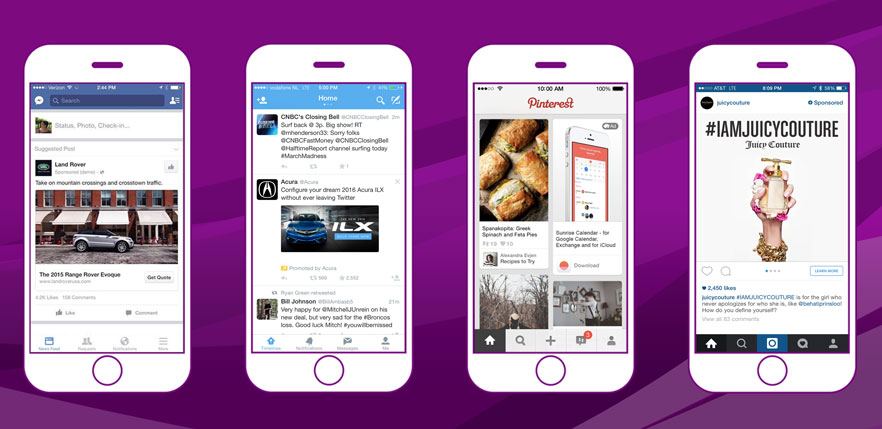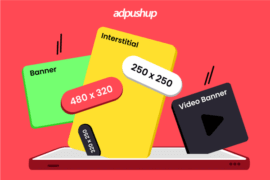Whether you already have an app or plan to develop one, app monetisation is a key component to boost your bottom line.
In this guide, we’ll do a thorough examination of app monetisation for publishers and app developers.
First, we’ll discuss what is app monetisation and weigh their advantages and disadvantages. Then, with various app monetization techniques, you’ll discover how to optimize and generate revenue from your app.
Given that this manual is lengthy, it will take some time to read. Fortunately, we’ve included helpful links to guide you to the appropriate sections.
What is App Monetization?
App monetization is a way for app developers and publishers to generate sustainable revenue with their app’s user base. Several strategies are applied during this process.
Mobile apps can generate revenue in various ways, including in-app advertising, in-app purchases, freemium models, and more. A number of factors determine which monetization methods will be most effective.
Key Statistics for App Monetisation:
- Revenue from apps for iOS and Android combined hit $133 billion in 2021, up 19% from the previous year. iOS generated 63% of all app sales in 2021.
- In 2021, games accounted for 67% of all app income. A whopping $37.3 billion came from Google Play or approximately 41% of the total.
- iOS was responsible for 75% of the $43.4 billion produced outside gaming in 2021.
- In 2021, subscription revenue grew to $15.5 billion, with iOS accounting for 78% of the rise.
- Users are spending more time on mobile apps. In 2018, the average American spent 3.6 hours on a mobile device per day. And 88% of this time was spent within apps.
What Makes App Monetization Crucial?
As of 2009, 77% of apps in the iOS App Store were paid. Today, only 10% require payment at download. Google Play store also has only 31% paid mobile apps.
This shift from paid to free user base makes app monetisation important.
However, in both app stores, paid apps are still being used because it is a consistent revenue source for apps, but as developers become more attracted to the prospect of recurring income from advertisements.
Read More: Best App Monetization Platforms for Publishers in 2023
Mobile Apps Monetisation: How do Apps Make Money?
By 2025, in-app spending will reach $270 billion annually. This statistic doesn’t even include in-app ad revenues and several other forms of monetization, which topped $31.9 billion in Q4 2020.
The takeaway? App monetization can yield big profits.
Let’s take a look at some common methods of app monetization.
1. In-App Advertising
In-app advertising is one of the very popular app monetisation methods. It’s similar to the traditional banner and sidebar ads used on websites.
While in-app advertising shares a lot of characteristics with traditional website ads, there are some key differences to keep in mind.
- Benefit: Simple app monetization and rapid implementation.
- Problem: it can impact the UX; it only generates significant cash if your app has a massive user base.
With in-app marketing and mobile ad networks, many apps would exist.
So, let’s examine the various styles of prevalent in-app advertising.
Read More: How are In-App Advertising rates Calculated?
I. Banner Ads
Banner Ads specifically refers to the use of rectangular ad sizes for displaying ads. The ad creative can be an image, text, or a combination of both these things.
However, publishers might have noticed that image-based banner ads are the most popular. The reasons for the widespread use of banner ads in the ad tech industry are that they can effectively help in building brand value, easy to implement, and can be used for retargeting.
Benefit: Banner ads can target the user based on the user’s data and preferences.
Problem: Lower click-through rate resulting in lower yield conversions. ·
Read More: Best Performing Banner Ads in 2023
Mobile Banner Ad Sizes

Mobile Leaderboard (320×50)

Mobile full page flex (320×320)

Large Mobile banner (320×100)

Square (250×250)

Small Square (200×200)
II. Native Ads
Native ads are a popular choice amongst publishers because they lead to a better user experience, and in most cases, higher overall revenue.
Blending in with the medium in which they’re displayed, native ads help advertisers overcome banner blindness and ultimately help publishers earn more from their websites.
Business Insider Intelligence reports that the spending on native ads will reach $8 billion in 2015, and by 2018, this figure is projected to rise to $21 billion.
Benefit: Native ad blends with the design elements of your app
Problem: Can sometimes affect user’s experience because they appear alongside the app’s content
Read More: Native Ads vs Display Ads: What’s Best for Publishers?
Open any social media app and take a look at the in-feed ads that appear. By far, these social media ads are the most common form of native advertising.

III. Interstitial Ads
Banner and Native advertisements are sometimes criticised for their intrusiveness. The same ads might be shown to the users as a full-screen advertisement as one possible answer to this issue. This happens between several user flows.
Thus, the term “interstitial.”
To get the most out of this strategy, you must understand your app’s users and how they interact with it. But make sure to preserve the user experience.
The best moment to send an interstitial ad is at the end of a flow.
For instance, when a level in a game app is finished. Utilizing interstitial advertising while the app is loading is also a smart idea. This gives the user time to comprehend the advertisement and consider its message.
Read More: Interstitial Ads: Best Practices For Publishers
2. Subscription Model for Apps Monetisation
To encourage users to use your app, you can ask them to pay a monthly subscription instead of charging them a large upfront fee. A subscription model is based on this idea.
1. Auto‑Renewable Subscriptions
Auto-renewable subscriptions expire after a specific period and then regenerate themselves.
This subscription model for apps monetization can be implemented in mobile games or other apps too.
For example, in a mobile game app, you can provide players an option to unlock access to an exclusive game version. For this feature, you can use auto-renewable subscription model.

II. Non‑Renewing Subscriptions
During a non-renewing subscription, the user subscribes for a set amount of time (1 month, 3 months, etc). Access to the content ends when the time runs out. They must resubscribe to continue accessing the content. However, they must do it manually, unlike with auto-renewables.
Benefit: The subscription model can generate stable revenue and exponentially increase your profit per user.
Problem: The main challenge of this type of app monetization is to convince users to pay a monthly subscription fee.
3. In-app Purchases for Monetizing Apps
Providing in-app purchases may be the best app monetization solution if you are in eCommerce or have a SaaS business.
I. Consumable
These are the in-app purchases that are made most frequently in mobile games. They most often relate to in-game money, extra health, or power-ups.
Consumables are things that vanish when the user purchases and uses them. Therefore, they are always suitable for repurchase. So naturally, each game distributes a small number of these objects to allow for further gameplay.
Players that dislike long wait periods and hassle will love this kind of in-app purchase. They can buy consumables now, for a price, if they want them.
II. Non-Consumable
Contrary to consumables, players have ongoing access to non-consumable products after they purchase them.
Unlocking a level, bonus game characters, cosmetic goods, and loot boxes are a few examples of non-consumable IAP items.
This kind of in-app purchase is intended to enable users to experience a game fully.
4. Affiliate Ads
You can earn money through affiliate advertisements by independently promoting other apps, products, and services.
Additionally, if the audience trusts the source, this strategy can be quite useful in converting.
Again, the user experience should be priortized at all times. Make sure to display right ads, to the right users, at the right time.
The ad can recommend an app related to the user’s situation when they are between levels or have completed a transaction or event within the app.
You can also join affiliate programs and promote different companies’ products through your in-app content. Then, when a user clicks on your affiliate link or graphic, visits the company’s website, or makes a purchase, you get a cut.
Read More: 5 Best High Ticket Affiliate Marketing Platforms in 2022
5. Rewarded Video Ads
In apps with heavy user engagement, such as games, app incentive adverts are widespread.
In this case, those who engage with the content are rewarded. As a result, if you watch a 30-second commercial, you can be offered a new life in a game.
For this to work, you have to get the prize and the advertisement just right. Keep the content as relevant to your readers as you can. Make sure the reward is appropriate and valuable to the user.
Read More: 8 Tips to Improve UX with Ads
6. Playable Ads
Playable ads are the revolutionary ad formats that have taken the gaming world by storm.
It is also to be noted that these dazzling, creative, easy-to-understand ads are not just confined to the gaming world but also sprawling across non-gaming websites.
They are light, eye-catching and engaging with high conversion rates. Although the initial cost of incorporating these ads can be high, greater returns are assured.
Read More: Learn How to Use Playable Ads for Maximum Profit
7. Offerwalls Ads
Offerwalls offer rewards for specific actions, such as completing surveys, playing games, downloading apps, or reaching certain levels.
Best In App Monetisation Strategies for 2023
1. Balance App Monetisation with UX
Although monetization is important, don’t let it blind you to the importance of user experience.
User experience is one of the most important factors in determining whether an app will be used again. However, if you plan to earn income from your app, you’ll need people to use it. Therefore, you’ll want to maintain a good UX for your users while monetizing.
Put yourself in the users’ shoes.
Do those big, flashing banner ads interfere with their enjoyment of the game, the video ads, or the article? Does the ad complement the experience?
Does that interstitial ad between levels feel smooth and comfortable to you, or is it too abrupt?
The best approach is to measure UX from the perspective of a user.
Read More: 8 Tips to Improve UX with Ads
2. A/B Testing for Monetization of Apps
A good mobile app should be light, easy to use, and fast.
The best way to do that is to A/B test every important component to see what works. Then, based on your A/B testing results, stay agile – and maximize your app’s revenue.
Consider A/B testing the following:
- Trial vs. freemium. Which method converts the free users to paying ones?
- Sponsored posts vs. traditional ads. UX-wise, which method is better? Which generates the most revenue?
- Clicks versus impressions. What is the best return on investment between cost per impression (CPM), cost per click (CPC), and cost per action (CPA)?
- Low prices vs. higher prices. Are you better off charging more and making fewer sales or charging less and making more for subscriptions or in-app purchases?
Mobile apps can be A/B tested in nearly every aspect. And A/B test results could sharpen your app monetization abilities, it is worth your effort.
3. Learn from Your Competitors:
Before implementing a new app monetization strategy, consider how your competitors monetize their apps.
Don’t copy them. However, it would be helpful to see whether they are doing anything you have yet to consider. Then, you can check if it’s working for them and is a good fit for your app.
Here are a few strategies to identify competing apps:
- Identify a broad category where your app fits in the major app stores. Apps with the most downloads in that category will likely be your top competitors.
- Check out your app’s reviews. Watch out for reviews that compare your app with others. You can find similar apps through these comparisons.
Do some research once you’ve identified your mobile app competitors. See how they make money by downloading their apps.
What kind of advertisements do they have? Do they offer a freemium subscription service? See what’s working and what isn’t, and learn from their app monetization strategy.
In Closing
In general, the impact of advertising on the app experience is worrying more and more developers. As a result, there is an expanding discussion.
Which ad type is ideal for safeguarding the user experience (while making more money), wonder developers?
Since the beginning of mobile banner ads, a lot has changed. Mobile app marketers have understood the importance of safeguarding the user experience to keep their apps alive.
Apps Monetisation: Choosing the Best
Which of these monetization techniques will therefore be most effective for your app?
In the end, you’ll need to combine various monetization strategies for the best outcomes. You must create a comprehensive approach incorporating more than one of the methods covered in this post to ensure you make money while maintaining a positive user experience.
Running advertising and giving consumers a choice to pay for an ad-free experience is a terrific illustration of how two monetization strategies may work together to great effect.
Mobile App Monetization: Key Takeaways
- Due to lower commission rates offered by the major app stores, subscription models are becoming more and more popular.
- A powerful method of generating income without degrading user experience is data monetization.
- Plan at all times; developing a mobile app monetization strategy is never too early.
- Hybrid app monetization techniques work well if you know your audience and find the proper mix.
- To improve your monetization, use data, and understand your audience. Then, continue gaining knowledge, adjusting, and monetizing your app’s audience.
Frequently Asked Questions
Depending on your business sector and app type, you can use one monetisation model or a combination of them at once. The following are examples of app monetisation models:
1. Advertising and affiliate marketing
2. In-app purchases
3. Paid subscriptions
4. Freemium
5. Sponsorship
6. Crowdfunding
7. Transaction revenue
Customers can pay to unlock functionality or purchase virtual goods from you (weapons, coins). The majority of games use this strategy to increase profits. These include:
1. In-app purchases
2. Affiliate income
3. Subscription
4. Freemium

Shubham is a digital marketer with rich experience working in the advertisement technology industry. He has vast experience in the programmatic industry, driving business strategy and scaling functions including but not limited to growth and marketing, Operations, process optimization, and Sales.






